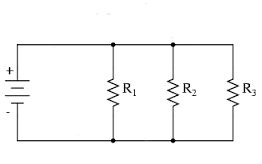Parallel CIrcuits
Claimed by Trevor Craport
This page covers one of the two types of basic circuits covered in this course, Parallel Circuits.
The Main Idea
Parallel circuits are a type of circuit that are composed of multiple paths that the current can pass through. With each separate path, the amount of current that runs through is equal to every individual path in the circuit, making the total current equal to the sum of each distinct path's current.
A Mathematical Model
What are the mathematical equations that allow us to model this topic. For example [math]\displaystyle{ {\frac{d\vec{p}}{dt}}_{system} = \vec{F}_{net} }[/math] where p is the momentum of the system and F is the net force from the surroundings.
A Computational Model
How do we visualize or predict using this topic. Consider embedding some vpython code here Teach hands-on with GlowScript
Examples
Be sure to show all steps in your solution and include diagrams whenever possible
Simple
Middling
Difficult
Connectedness
- How is this topic connected to something that you are interested in?
- How is it connected to your major?
- Is there an interesting industrial application?
History
Put this idea in historical context. Give the reader the Who, What, When, Where, and Why.
See also
Parallel Circuits are just one component of the total circuit composition. In this physics book page, there are further extensions on the other basic type of circuit as well as many variations of the calculations that can be made from them.
http://www.physicsbook.gatech.edu/Series_Circuits
http://www.physicsbook.gatech.edu/Parallel_Circuits_vs._Series_Circuits*
http://www.physicsbook.gatech.edu/Loop_Rule
http://www.physicsbook.gatech.edu/Node_Rule
External links
Internet resources on this topic
References
This section contains the the references you used while writing this page
